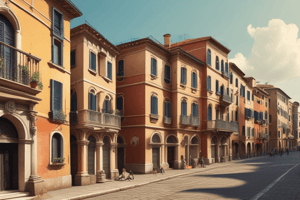Podcast
Questions and Answers
What is the meaning of the 'Italian hand gesture'?
What is the meaning of the 'Italian hand gesture'?
- To express approval
- To greet friends and family
- To show respect to elders
- To express uncertainty or disbelief (correct)
What is the purpose of raised eyebrows and a quick nod in Italy?
What is the purpose of raised eyebrows and a quick nod in Italy?
- To indicate agreement (correct)
- To express disagreement
- To ask a question
- To show excitement
How do Italians typically greet friends and family?
How do Italians typically greet friends and family?
- With a kiss on both cheeks (correct)
- With a kiss on one cheek
- With a handshake
- With a bow
What does 'Certo, mi piacerebbe!' mean in English?
What does 'Certo, mi piacerebbe!' mean in English?
What is the Italian translation for the number 50?
What is the Italian translation for the number 50?
What is the context of the conversation between A and B?
What is the context of the conversation between A and B?
What is the formal way of saying 'hello' or 'hi' in Italian?
What is the formal way of saying 'hello' or 'hi' in Italian?
What is the significance of maintaining eye contact in Italian non-verbal communication?
What is the significance of maintaining eye contact in Italian non-verbal communication?
What does 'Piacere' mean in Italian?
What does 'Piacere' mean in Italian?
What is the typical response to 'Come stai?' in Italian?
What is the typical response to 'Come stai?' in Italian?
What is notable about Italian gestures in non-verbal communication?
What is notable about Italian gestures in non-verbal communication?
What is the phrase used to wish someone good luck in Italian?
What is the phrase used to wish someone good luck in Italian?
What is the Italian translation of 'nine'?
What is the Italian translation of 'nine'?
What does 'alle' typically translate to in English when referring to time?
What does 'alle' typically translate to in English when referring to time?
What is the Italian translation of 'January'?
What is the Italian translation of 'January'?
What is the Italian translation of 'Monday'?
What is the Italian translation of 'Monday'?
What time is 'alle due meno un quarto' in English?
What time is 'alle due meno un quarto' in English?
What is the Italian translation of 'August'?
What is the Italian translation of 'August'?
Flashcards are hidden until you start studying
Study Notes
Gestures and Facial Expressions
- Italians use the "Italian hand gesture" (fingers together, moving up and down) to express uncertainty or disbelief
- A "thumbs up" is used to show approval
- Raised eyebrows and a quick nod may indicate agreement, while a frown may express disagreement or concern
Kissing on Cheeks
- Italians greet friends and family with a kiss on both cheeks
- The number of kisses may vary by region
Greetings
- Informal greetings: Ciao (Hello/Hi/Goodbye), Come stai? (How are you?)
- Formal greetings: Salve (Hello/Hi), Come sta? (How are you?)
- Good morning: Buongiorno
- Good afternoon: Buon pomeriggio
- Good evening: Buonasera
- Good night: Buonanotte
Introductions
- Self-introduction: Ciao! Sono [Your Name]. Da dove vieni? (Hello! I'm [Your Name]. Where are you from?)
- Response: Ciao! Sono [Their Name]. Piacere! So no dalle Filippine (Hello! I'm [Their Name]. Nice to meet you! I'm from the Philippines)
Numbers
- 0 - zero
- 1 - uno
- 2 - due
- 3 - tre
- 10 - dieci
- 100 - cento
- 1000 - mille
- 2000 - duemila
- 10,000 - diecimila
- 1,000,000 - un milione
- 10,000,000 - dieci milioni
- 100,000,000 - cento milioni
- 2,000,000,000 - due bilioni
Time
- "Alle" in Italian typically translates to "at" or "at the" when referring to time
- Examples: L'appuntamento è alle nove (The appointment is at nine), Il film inizia alle otto (The movie starts at eight), Ci vediamo alle tre (We'll see each other at three)
Months
-
- Gennaio - January
-
- Febbraio - February
-
- Marzo - March
-
- Aprile - April
-
- Maggio - May
-
- Giugno - June
-
- Luglio - July
-
- Agosto - August
-
- Settembre - September
-
- Ottobre - October
-
- Novembre - November
-
- Dicembre - December
Days
- Lunedì - Monday
- Martedì - Tuesday
- Mercoledì - Wednesday
- Giovedì - Thursday
- Venerdì - Friday
- Sabato - Saturday
- Domenica - Sunday
Studying That Suits You
Use AI to generate personalized quizzes and flashcards to suit your learning preferences.




